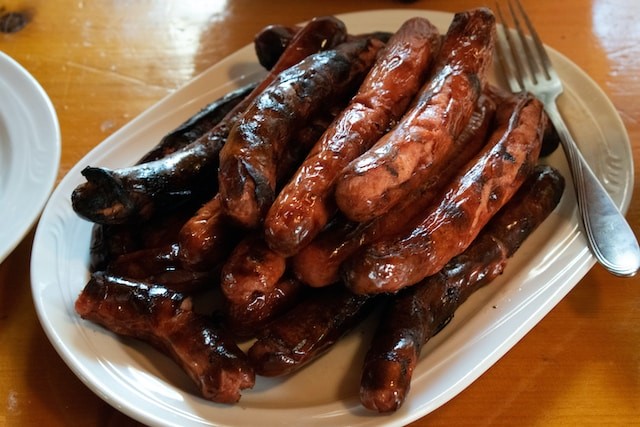Lab-Grown Fat Enhances Cultured Meat's Flavor and Texture!
Researchers have successfully bulk-produced fat tissue in the lab that has a similar texture and make-up to naturally occurring fats from animals. [1]
The findings, outlined in a recent study released in eLife, have the potential to be utilized in the development of lab-grown meat that is derived solely from cells, enhancing its texture and flavor to make it more authentic. [1]

Figure 1. Lab-grown fat
Figure 1 shows Researchers have successfully created fat tissue in the lab that may help give lab-grown meat, like these sausages, a more realistic texture and flavour. In recent news, cultivated meat has been receiving significant attention, as numerous startup companies globally are actively working on the development of cell-grown chicken, beef, pork, and fish. While these endeavors are still in the early stages and not yet ready for large-scale production, a few exceptions aside, they have not yet obtained commercial approval. Presently, most of the products being developed consist of an unstructured blend of cells, resembling chicken nuggets rather than a traditional slice of chicken breast. However, what is currently lacking in these products is the authentic texture found in real meat, which is primarily attributed to the presence of muscle fibers, connective tissue, and fat. Particularly, it is the fat content that contributes to the distinct flavor of the meat. [1]
Indeed, when consumer testing was conducted using natural beef varieties with varying fat content, the results indicated that the highest ratings were given to beef samples containing 36% fat. [1]
Nevertheless, one of the significant obstacles in producing cultured fat tissue on a large scale has been the inherent difficulty of maintaining adequate oxygen and nutrient supply to the cells as the fat mass expands. In natural circumstances, blood vessels and capillaries play a crucial role in delivering oxygen and nutrients throughout the tissue. Unfortunately, researchers have yet to discover a method to replicate a fully functional vascular network on a large scale in lab-grown tissue. As a result, they are currently limited to growing muscle or fat to a few millimeters in size, as they have not found a solution to replicate the intricate vascular system necessary for larger growth. [1]
To overcome this constraint, the researchers adopted an innovative approach. Initially, they cultivated fat cells derived from mice and pigs in a two-dimensional layer. Subsequently, these cells were harvested and consolidated into a three-dimensional mass using a binder such as alginate and mTG. Notably, both alginate and mTG are already utilized in certain food products, making them suitable choices for this purpose. This technique allowed the researchers to address the challenge of limited cell growth and create a more substantial and structurally complex fat tissue. [1]
“Our goal was to develop a relatively simple method of producing bulk fat. Since fat tissue is predominantly cells with few other structural components, we thought that aggregating the cells after growth would be sufficient to reproduce the taste, nutrition, and texture profile of natural animal fat,” says first author John Yuen Jr, a graduate student at the Tufts University Center for Cellular Architecture (TUCCA), Massachusetts, US. “This can work when creating the tissue solely for food, since there’s no requirement to keep the cells alive once we gather the fat in bulk.” [1]
Upon aggregation, the fat cells exhibited an immediate resemblance to actual fat tissue. However, to determine whether these aggregated cells truly replicated the characteristics of native animal fat, the research team proceeded to conduct a series of additional experiments. These subsequent tests were designed to thoroughly examine and assess the features and properties of the lab-grown fat tissue in comparison to the fat found in animals. [1]
The researchers initiated their investigation by focusing on the texture aspect. They applied compression to the lab-grown fat tissue and compared its ability to withstand pressure with that of natural animal fat. The results revealed that cell-grown fat, when combined with sodium alginate as a binder, exhibited a comparable resistance to pressure as fat derived from livestock and poultry. Conversely, when the cell-grown fat was bound with mTG, it displayed characteristics similar to rendered fat, such as lard or tallow. This finding suggests that it may be feasible to refine the texture of cultured fat to closely resemble the authentic texture of fat within the meat. Achieving this could involve using different types and quantities of binders to achieve the desired outcome. [1]
Cooking meat releases a multitude of flavor-enhancing compounds, with a significant portion originating from fat, including lipids and their constituent fatty acids. Recognizing this, the research team analyzed the molecular composition of the cell-grown fat. They observed that the mix of fatty acids obtained from cultured mouse fat differed from that of native mouse fat. However, the cultured pig fat exhibited a much closer fatty acid profile to its natural counterpart. [1]
Based on their preliminary findings, the researchers propose the potential supplementation of growing fat cells with the necessary lipids. This approach aims to ensure a closer resemblance between the cultured fat and the composition of lipids found in natural meat. By providing the growing cells with specific lipids, there is a possibility of achieving a more precise match to the natural fatty acid composition present in traditional meat. [1]
“This method of aggregating cultured fat cells with binding agents can be translated to large-scale production of cultured fat tissue in bioreactors – a key obstacle in the development of cultured meat,” says senior author David Kaplan, Stern Family professor of Biomedical Engineering at Tufts University and director of TUCCA. “We continue to look at every aspect of cultured meat production to enable mass production of meat that looks, tastes, and feels like the real thing.” [1]
Source: eLife
References:
- https://elifesciences.org/for-the-press/11a59fef/lab-grown-fat-could-give-cultured-meat-real-flavour-and-texture
Cite this article:
Hana M (2023), Lab-Grown Fat Enhances Cultured Meat's Flavor and Texture!, AnaTechmaz, pp.437

